Band Structures Analysis Method of Two-Dimensional Phononic Crystals Using Wavelet-Based Elements
Abstract
:1. Introduction
2. Theoretical Development
3. Numerical Investigation
4. Conclusions
Acknowledgments
Author Contributions
Conflicts of Interest
References
- Kushwaha, M.S.; Halevi, P.; Dobrzynski, L.; Djafari-rouhani, B. Acoustic band structure of periodic elastic composites. Phys. Rev. Lett. 1993, 71, 2022–2025. [Google Scholar] [CrossRef] [PubMed]
- Jensen, J.S. Phononic band-gaps and vibrations in one- and two-dimensional mass-spring structures. J. Sound Vib. 2003, 266, 1053–1078. [Google Scholar] [CrossRef]
- Yu, D.L.; Wen, J.H.; Zhao, H.G.; Liu, Y.Z.; Wen, X.S. Vibration reduction by using the idea of phononic crystals in a pipe-conveying fluid. J. Sound Vib. 2008, 318, 193–205. [Google Scholar] [CrossRef]
- Hussein, M.I.; Leamy, M.J.; Ruzzene, M. Dynamics of phononic materials and structures: Historical origins, recent progress, and future outlook. Appl. Mech. Rev. 2014, 66, 040802. [Google Scholar] [CrossRef]
- Hsu, P.C.; Wu, T.T.; Hsu, J.C.; Sun, J.H. Directional enhanced acoustic radiation caused by a point cavity in a finite-size two-dimensional phononic crystal. Appl. Phys. Lett. 2008, 93, 201904. [Google Scholar] [CrossRef]
- Kafesaki, M.; Sigalas, M.M.; Garcia, N. Frequency modulation in the transmittivity of wave guides in elastic-wave band-gap materials. Phys. Rev. Lett. 2000, 85, 4044–4047. [Google Scholar] [CrossRef] [PubMed]
- Mazzotti, M.; Miniaci, M.; Bartoli, I. Band structure analysis of leaky Bloch waves in 2D phononic crystal plates. Ultrasonics 2017, 74, 140–143. [Google Scholar] [CrossRef] [PubMed]
- Lian, Z.Y.; Jiang, S.; Hu, H.P.; Dai, L.X.; Chen, X.D.; Jiang, W. An enhanced plane wave expansion method to solve piezoelectric phononic crystal with resonant shunting circuits. Shock Vib. 2016. [Google Scholar] [CrossRef]
- Liu, Z.Y.; Chan, C.T.; Sheng, P. Elastic wave scattering by periodic structures of spherical objects: Theory and experiment. Phys. Rev. B 2000, 62, 2446–2457. [Google Scholar] [CrossRef]
- Cao, Y.J.; Hou, Z.L.; Liu, Y.Y. Finite difference time domain method for band-structure calculations of two-dimensional phononic crystals. Solid State Commu. 2004, 132, 539–543. [Google Scholar] [CrossRef]
- Sigalas, M.M.; Garcia, N. Theoretical study of three dimensional elastic band-gaps with the finite difference time-domain method. J. Appl. Phys. 2000, 87, 3122–3125. [Google Scholar] [CrossRef]
- Wang, G.; Wen, J.H.; Liu, Y. Lumped-mass method for the study of band structure in two-dimensional phononic crystals. Phys. Rev. B 2004, 69, 184302. [Google Scholar] [CrossRef]
- Yan, Z.Z.; Wang, Y.S. Wavelet-based method for calculating elastic band-gaps of two-dimensional phononic crystals. Phys. Rev. B 2006, 74, 224303. [Google Scholar] [CrossRef]
- Yan, Z.Z.; Wang, Y.S. Calculation of band structures for surface waves in two-dimensional phononic crystals with a wavelet-based method. Phys. Rev. B 2008, 78, 094306. [Google Scholar] [CrossRef]
- Li, F.L.; Wang, Y.S.; Zhang, C.Z.; Yu, G.L. Boundary element method for band-gap calculations of two-dimensional solid phononic crystals. Eng. Anal. Bound. Elem. 2013, 37, 225–235. [Google Scholar] [CrossRef]
- Degrande, G.; Clouteau, D.; Othman, R.; Arnst, M.; Chebli, H.; Klein, R.; Chaherjee, P.; Janssens, B. A numerical model for ground-borne vibrations from underground railway traffic based on a periodic finite element—boundary element formulation. J. Sound Vib. 2006, 293, 645–666. [Google Scholar] [CrossRef]
- Karimi, M.; Croaker, P.; Kessissoglou, N. Acoustic scattering for 3D multi-directional periodic structures using the boundary element method. J. Acoust. Soc. Am. 2017, 141, 313–323. [Google Scholar] [CrossRef] [PubMed]
- Cerny, R. Crystal Structures from powder diffraction: Principles, difficulties and progress. Crystals 2017, 7, 142. [Google Scholar] [CrossRef]
- Lemoult, F.; Kaina, N.; Fink, M.; Lerosey, G. Soda cans metamaterial: A subwavelength-scaled phononic crystal. Crystals 2016, 6, 82. [Google Scholar] [CrossRef]
- Wang, Y.F.; Maznev, A.A.; Laude, V. Formation of bragg band-gaps in anisotropic phononic crystals analyzed with the empty lattice model. Crystals 2016, 6, 52. [Google Scholar] [CrossRef]
- Li, L.F.; Guo, Y.Q. Analysis of longitudinal waves in rod-type piezoelectric phononic crystals. Crystals 2016, 6, 45. [Google Scholar] [CrossRef]
- Han, L.; Zhang, Y.; Li, X.M.; Jiang, L.H.; Chen, D. Accelerated approach for the band structures calculation of phononic crystals by finite element method. Crystals 2016, 6, 11. [Google Scholar] [CrossRef]
- Andreassen, E.; Jensen, J.S. Analysis of phononic bandgap structures with dissipation. J. Vib. Acoust. 2013, 135, 041015. [Google Scholar] [CrossRef]
- Collet, M.; Ouisse, M.; Ruzzene, M.; Ichchou, M.N. Floquet-Bloch decomposition for the computation of dispersion of two-dimensional periodic, damped mechanical systems. Int. J. Solids Struct. 2011, 48, 2837–2848. [Google Scholar] [CrossRef]
- Eatwell, G. Free-wave propagation in an irregularly stiffened, fluid-loaded plate. J. Sound Vib. 1983, 88, 507–522. [Google Scholar] [CrossRef]
- Hussein, M.I. Reduced Bloch mode expansion for periodic media band structure calculations. Proc. R. Soc. A 2009, 465, 2825–2848. [Google Scholar] [CrossRef]
- Veres, I.A.; Berer, T.; Matsuda, O. Complex band structures of two dimensional phononic crystals: Analysis by the finite element method. J. Appl. Phys. 2013, 114, 083519. [Google Scholar] [CrossRef]
- Galich, P.I.; Fang, N.X.; Boyce, M.C.; Rudykh, S. Elastic wave propagation in finitely deformed layered materials. J. Mech. Phys. Solids. 2017, 98, 390–410. [Google Scholar] [CrossRef]
- Rudykh, S.; Boyce, M.C. Transformating wave propagation in layered media via instability-induced interfacial wrinkling. Phys. Rev. Lett. 2014, 112, 034301. [Google Scholar] [CrossRef] [PubMed]
- Chen, X.F.; Xiang, J.W.; Li, B.; He, Z.J. A study of multiscale wavelet-based elements for adaptive finite element analysis. Adv. Eng. Softw. 2010, 41, 196–205. [Google Scholar] [CrossRef]
- Chen, X.F.; Yang, Z.B.; Zhang, X.W.; He, Z.J. Modeling of wave propagation in one-dimension structures using B-spline wavelet on interval finite element. Finite Elem. Anal. Des. 2012, 51, 1–9. [Google Scholar] [CrossRef]
- Chen, X.F.; Yang, S.J.; Ma, J.X.; He, Z.J. The construction of wavelet finite element and its application. Finite Elem. Anal. Des. 2004, 40, 541–554. [Google Scholar] [CrossRef]
- Xiang, J.W.; Chen, X.F.; He, Z.J.; Dong, H.B. The construction of 1D wavelet finite elements for structural analysis. Comput. Mech. 2007, 40, 325–339. [Google Scholar] [CrossRef]
- Xiang, J.W.; Chen, X.F.; He, Y.M.; He, Z.J. The construction of plane elastomechanics and mindlin plate elements of B-spline wavelet on the interval. Finite Elem. Anal. Des. 2006, 42, 1269–1280. [Google Scholar] [CrossRef]
- Xiang, J.W.; Chen, X.F.; He, Y.M.; He, Z.J. Static and vibration analysis of thin plates by using finite element method of b-spline wavelet on the interval. Struct. Eng. Mech. 2007, 25, 613–630. [Google Scholar] [CrossRef]
- Xiang, J.W.; Chen, X.F.; He, Z.J.; Zhang, Y.H. A new wavelet-based thin plate element using B-spline wavelet on the interval. Comput. Mech. 2008a, 41, 243–255. [Google Scholar]
- Xiang, J.W.; Chen, X.F.; Yang, L.F.; He, Z.J. A class of wavelet-based flat shell elements using B-spline wavelet on the interval and its applications. CMES Comput. Model. Eng. Sci. 2008b, 23, 1–12. [Google Scholar]
- Xiang, J.W.; Liang, M. Multiple damage detection method for beams based on multi-scale elements using Hermite cubic spline wavelet. CMES Comput. Model. Eng. Sci. 2011, 73, 267–298. [Google Scholar]
- Xiang, J.W.; Matsumoto, T.; Wang, Y.X.; Jiang, Z.S. A hybrid of interval wavelets and wavelet finite element model for damage detection in structures. CMES Comput. Model. Eng. Sci. 2011, 81, 269–294. [Google Scholar]
- Zhang, X.W.; Chen, X.F.; Wang, X.Z.; He, Z.J. Mutivariable finite elements based on B-spline wavelet on the interval for thin plate static and vibration analysis. Finite Elem. Anal. Des. 2010, 46, 416–427. [Google Scholar] [CrossRef]
- Zhang, X.W.; Chen, X.F.; Yang, Z.B.; Shen, Z.J. Multivariable wavelet finite element for flexible skew thin plate analysis. Sci. China-Technol. Sci. 2014, 57, 1532–1540. [Google Scholar] [CrossRef]
- Zuo, H.; Yang, Z.B.; Chen, X.F.; Xie, Y.; Miao, H.H. Analysis of laminated composite plates using wavelet finite element method and higher-order plate theory. Compos. Struct. 2015, 131, 248–258. [Google Scholar] [CrossRef]
- Yang, Z.B.; Radzienski, M.; Kudela, P.; Ostachowicz, W. Two-dimensional modal curvature estimation via Fourier spectral method for damage detection. Compos. Struct. 2016, 148, 155–167. [Google Scholar] [CrossRef]
- Yang, Z.B.; Chen, X.F.; Li, X.; Jiang, Y.Y.; Miao, H.H.; He, Z.J. Wave motion analysis in arch structures via wavelet finite element method. J. Sound Vib. 2014, 333, 446–469. [Google Scholar] [CrossRef]
- Checoury, X.; Lourtioz, J.M. Wavelet method for computing band diagrams of 2D photonic crystals. Opt. Commu. 2006, 259, 360–365. [Google Scholar] [CrossRef]
- Yan, Z.Z.; Wang, Y.S.; Zhang, C.Z. Wavelet-based method for calculating the defect states of two-dimensional phononicx crystals. Acta Mech. Solida Sin. 2008, 21, 104–109. [Google Scholar] [CrossRef]
- Dijkema, T.J.; Schwab, C.; Stevenson, R. An adaptive wavelet method for solving high-dimensional elliptic PDEs. Constr. Approx. 2009, 30, 423–455. [Google Scholar] [CrossRef]
- Liu, M.; Xiang, J.W.; Gao, H.F.; Jiang, Y.Y.; Zhou, Y.Q.; Li, F.P. Research on band structure of one-dimensional phononic crystals based on wavelet finite element method. CMES Comput. Model. Eng. Sci. 2014, 97, 425–436. [Google Scholar]
- Duhamel, D.; Mace, B.R.; Brennan, M.J. Finite element analysis of the vibrations of waveguides and periodic structures. J. Sound Vib. 2006, 294, 205–220. [Google Scholar] [CrossRef]
- EI-Naggar, S.A.; Mostafa, S.I.; Rafat, N.H. Complete band gaps of phononic crystal plates with square rods. Ultrasonics 2012, 52, 536–542. [Google Scholar] [CrossRef] [PubMed]

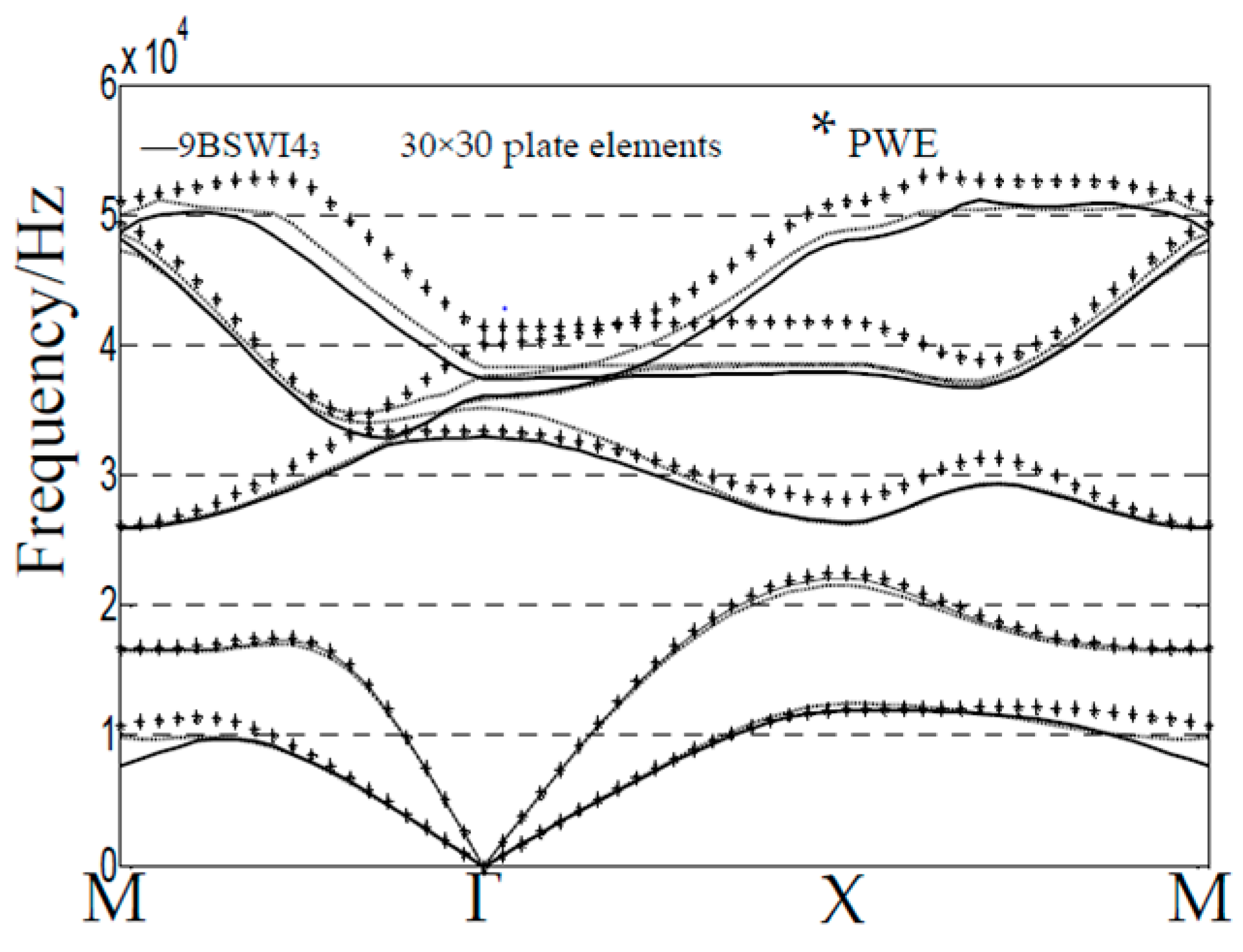
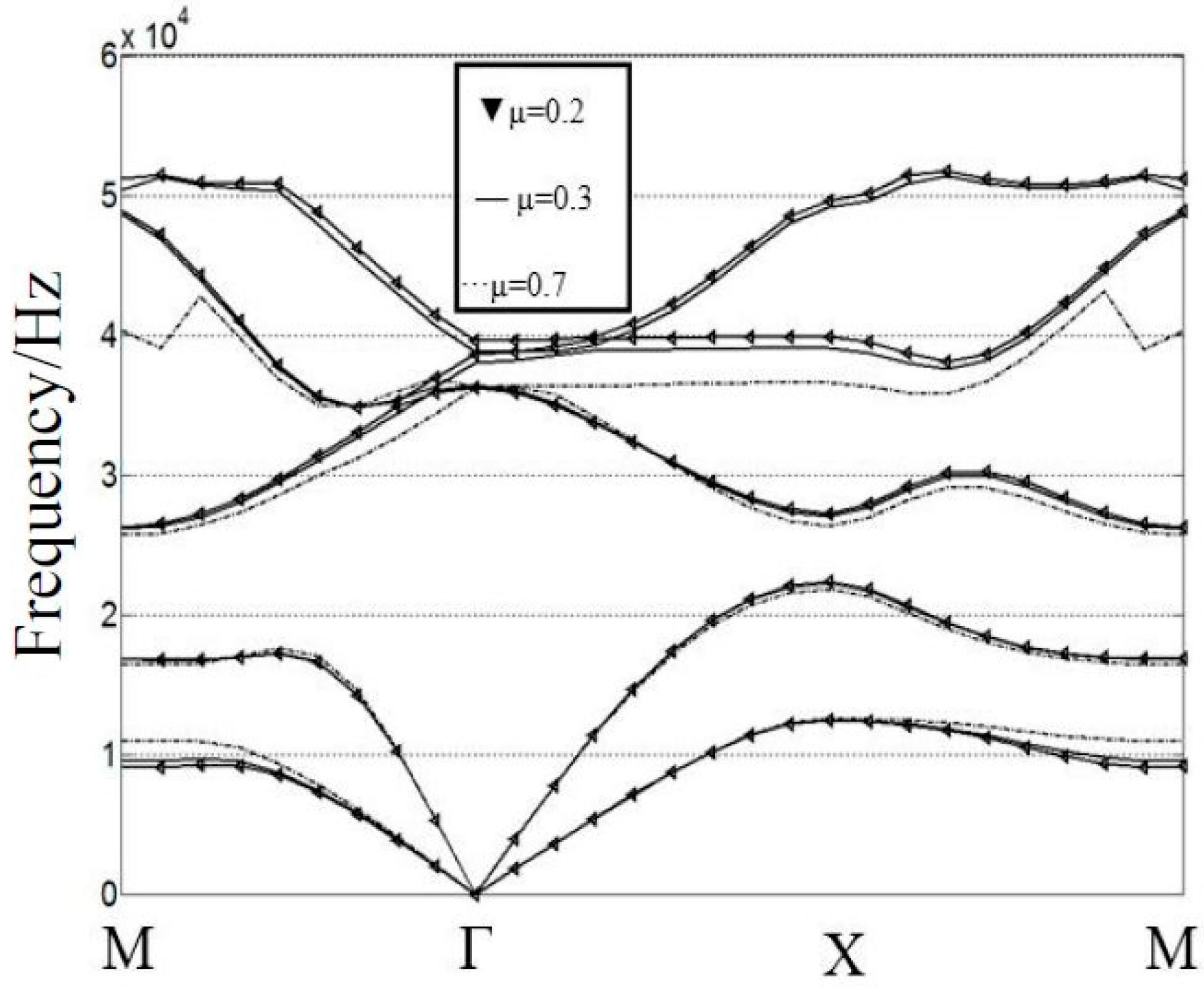
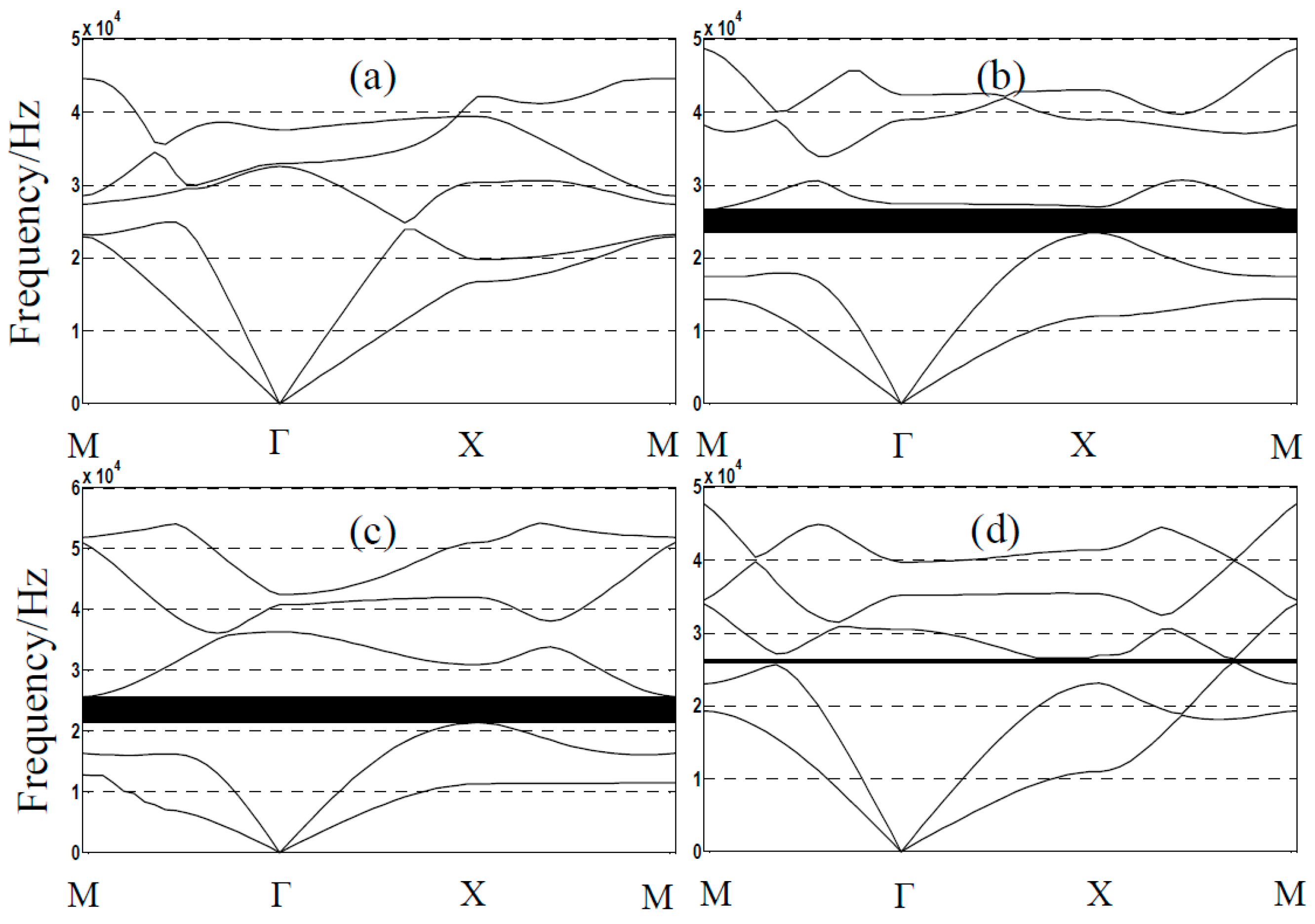
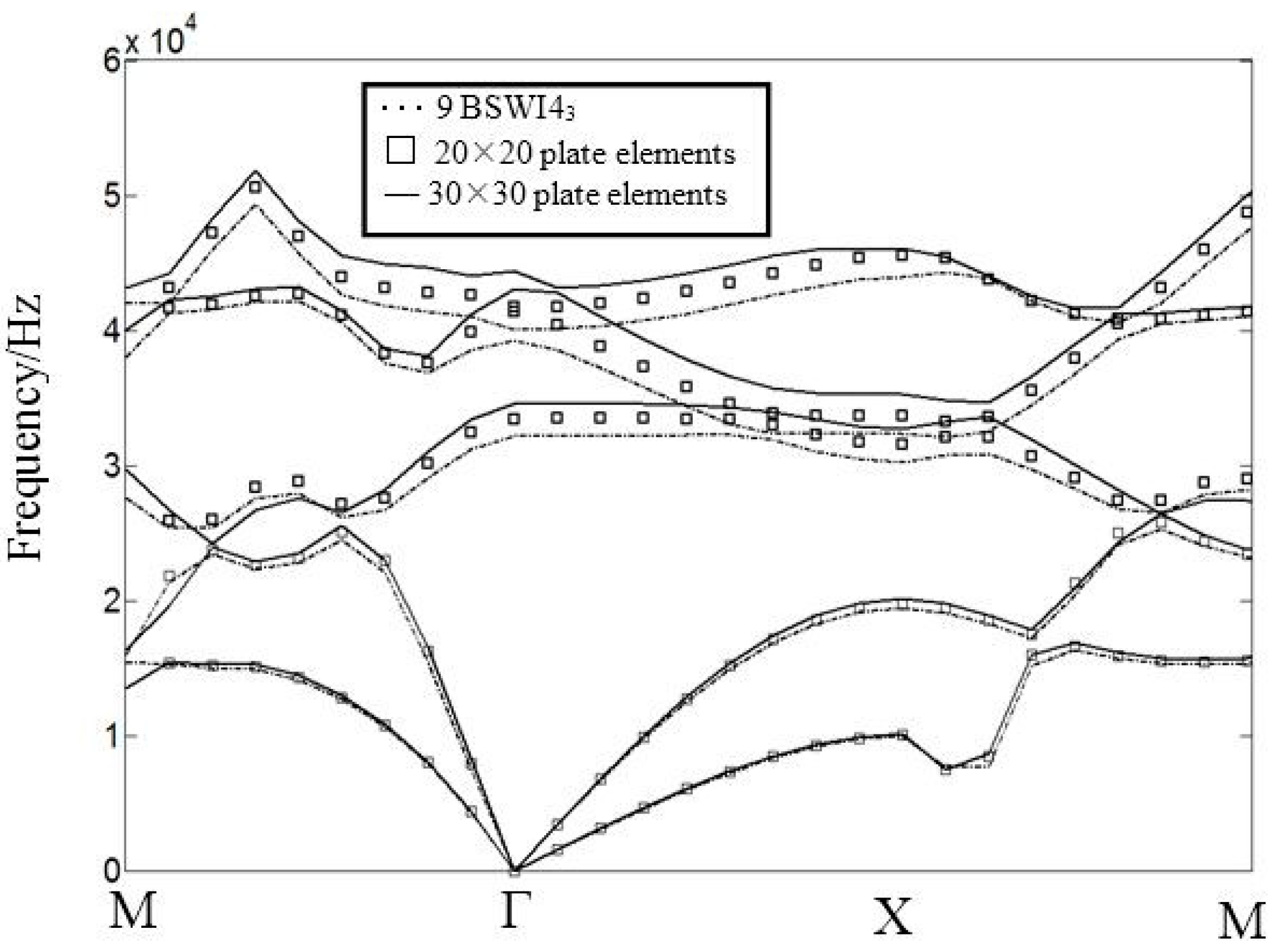
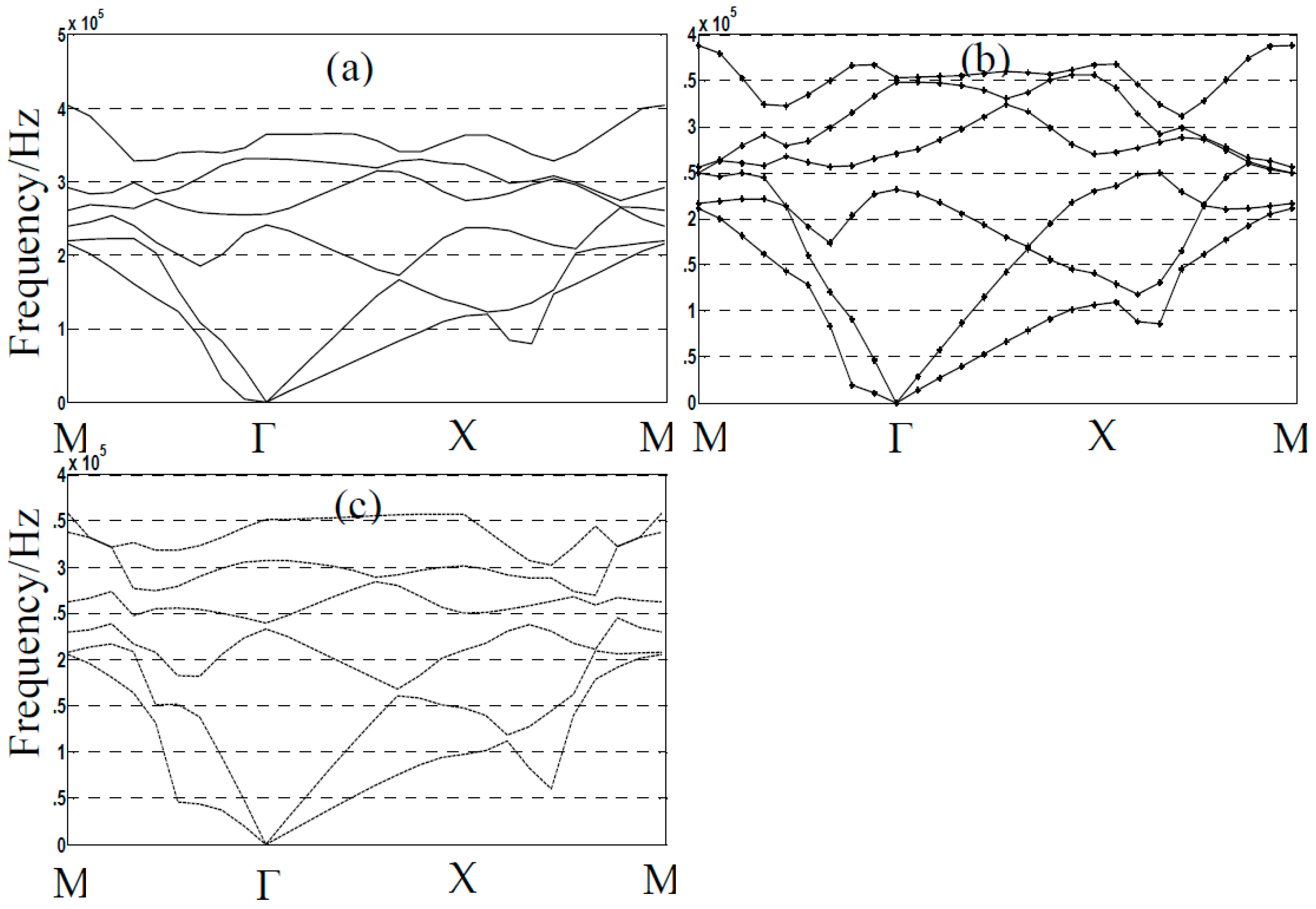

| Materials | Density(ρ) (Kg/m3) | Young’s Modules(E)1010 Pa | Possion’s Ratios (ν) |
|---|---|---|---|
| Lead | 11,600 | 4.08 | 0.369 |
| Epoxy | 1180 | 0.435 | 0.368 |
© 2017 by the authors. Licensee MDPI, Basel, Switzerland. This article is an open access article distributed under the terms and conditions of the Creative Commons Attribution (CC BY) license (http://creativecommons.org/licenses/by/4.0/).
Share and Cite
Liu, M.; Xiang, J.; Zhong, Y. Band Structures Analysis Method of Two-Dimensional Phononic Crystals Using Wavelet-Based Elements. Crystals 2017, 7, 328. https://doi.org/10.3390/cryst7110328
Liu M, Xiang J, Zhong Y. Band Structures Analysis Method of Two-Dimensional Phononic Crystals Using Wavelet-Based Elements. Crystals. 2017; 7(11):328. https://doi.org/10.3390/cryst7110328
Chicago/Turabian StyleLiu, Mao, Jiawei Xiang, and Yongteng Zhong. 2017. "Band Structures Analysis Method of Two-Dimensional Phononic Crystals Using Wavelet-Based Elements" Crystals 7, no. 11: 328. https://doi.org/10.3390/cryst7110328






